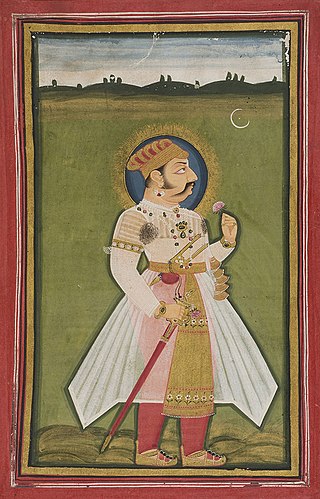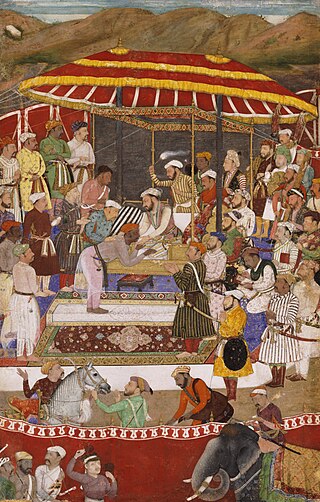| Battle of Ranakpur | |||||||
|---|---|---|---|---|---|---|---|
| |||||||
| Belligerents | |||||||
| | | ||||||
| Commanders and leaders | |||||||
| Amar Singh I Other Mewari chieftains | Abdullah Khan | ||||||
| Casualties and losses | |||||||
| Heavy | Heavy | ||||||
The Battle of Ranakpur (Ranpur) was fought between the Mewar and the Mughal Empire
| Battle of Ranakpur | |||||||
|---|---|---|---|---|---|---|---|
| |||||||
| Belligerents | |||||||
| | | ||||||
| Commanders and leaders | |||||||
| Amar Singh I Other Mewari chieftains | Abdullah Khan | ||||||
| Casualties and losses | |||||||
| Heavy | Heavy | ||||||
The Battle of Ranakpur (Ranpur) was fought between the Mewar and the Mughal Empire
Soon after his accession, Jahangir initiated numerous campaigns to subdue Mewar. In 1606, an army of 20,000 cavalry was dispatched to attack Mewar. Rana Amar Singh led a hard-fought battle to defend his territory and personally slew the Mughal commander. [3] In 1608, an army under Mahabat Khan was sent to Mewar through Mandal and Chittor. This army too was defeated and had to retreat because of continuous raids by Rajput forces. [4] In 1609, Mahabat Khan was replaced with Abdullah Khan who was able to achieve initial success from 1609 to 1611. In an attack by Abdullah Khan on Chavand about 2000-3000 Rajputs staying there fought till death and Amar Singh was forced to abandon the capital. [5]
After initial setbacks, Rana reorganized his army, and a fierce battle unfolded between the Mewari and Mughal forces of Abdullah at Ranakpur, near Kumbhalgarh, resulting in significant casualties on both sides. The Mewari forces emerged victorious, turning Abdullah Khan's campaign in Mewar, despite its initial success, into a total failure. He was subsequently called back and sent to Gujarat. [6]
After Abdullah, Raja Basu was appointed to the command of the Mughul army in Rajasthan. But he too failed to meet the objectives. He was recalled and Khan A‘zam Mirza Aziz Koka sent in 1613 to replace him.Upon his request for assistance, in 1613, Jahangir himself came to Rajputana to supervise the campaign. His son Khurram led the campaign on the ground.Many attempts were made by Jahangir to make settlements with the Maharana and the final attempt in 1615 succeeded when Maharana Amar Singh agreed to meet with Prince Khurram. [7]
Maharana Hammir Singh (1302–1364), or Hammir, was a 14th-century ruler of Mewar in present-day Rajasthan, India. Hammir Singh, was a scion of the cadet branch Rana of the Guhila dynasty, who regained control of the region, re-established the dynasty after defeating the Tughlaq dynasty, and captured present-day Rajasthan from Muslim forces of Delhi and became the first of the 'Rana' branch to become the King of Mewar with title of Maharana. Hammir also became the progenitor of the Sisodia clan, a branch of the Guhila dynasty, to which every succeeding Maharana of Mewar has belonged.

Rana Kumbha or Kumbhkaran Singh (1433–1468), popularly known as Maharana Kumbha, was the ruler of the Kingdom of Mewar. He belonged to the Sisodia clan of Rajputs. It was during his reign that Mewar became one of the most powerful political powers in northern India. He is said to be the most potentially stabled sovereign of his time and his dynasty in general.

The battle of Haldighati was fought on 18 June 1576 between the Mewar forces led by Maharana Pratap, and the Mughal forces led by Man Singh I of Amber. The Mughals carried the day after inflicting significant casualties on Mewar forces, although they failed to capture Pratap, who reluctantly retreated persuaded by his fellow commanders.

The Kingdom of Mewar, sometimes known as Udaipur State, was an independent kingdom in Rajputana region of India, ruled by the Sisodia dynasty. It was established around the 6th century by the minor rulers of the Nagada-Ahar region of Udaipur and later, in the 10th century, it transformed into an independent state under Rawal Bharttripatta II.
Raimal Singh Sisodia, also known as Rana Raimal, was a Hindu Rajput ruler of Mewar. Maharana Raimal was the son of Rana Kumbha and his Rathore queen, a princess of Idar.

The siege of Chittorgarh was the military expedition of the Mughal Empire under Akbar against the Mewar kingdom that commenced in 1567 during which the Mughals successfully captured the fort of Chittorgarh after a hard-pressed siege which lasted for several months.
The Mughal–Rajput wars were a series of battles between the Rajput Confederacy and the Mughal Empire. The conflicts originated with the invasion of northwestern India by the Mughal ruler Babur, to which the head of the Rajput confederacy, Rana Sanga, offered staunch resistance.
Hindu Rajput kingdoms in the north-western Indian subcontinent resisted the Muslim invasions of India, beginning with the Umayyad campaigns from the Middle East and the Ghaznavid Turks from Central Asia. They continued resistance against subsequent Muslim empires, including the Arabs, Ghaznavids, Ghurids, Delhi Sultans and the Mughals.

Maharana Amar Singh I, the Maharana ruler of Mewar Kingdom, was the eldest son and successor of Maharana Pratap I.He was the 14th Rana of Mewar,ruling from January 19, 1597 till his death on January 26, 1620.

Maharana Raj Singh I, was the Maharana of Mewar Kingdom and eldest son of Maharana Jagat Singh I. He fought against Mughal Empire and annexed many Mughal territories He participated in Rajput-Mughal War (1679–1707) and defeated the Mughals.

Maharana Jai Singh, was the Maharana of Mewar Kingdom, ruling from 1680 to 1698. He was the eldest son of Maharana Raj Singh I. Jai Singh fought a series of battles against Mughal Emperor Aurangzeb. In 1680–81, he sent his noble Dayaldas in Malwa. Dayaldas occupied Dhar and Mandu. He looted those cities and fought a series of battles against Mughal army. He built Dhebar lake also known as Jaisamand, in the year 1685.
Rana Ratan Singh II was the Maharana of Mewar Kingdom. He was a son of Rana Sanga. He was killed during a war in 1531. He was succeeded by his surviving brother Vikramaditya Singh.
The Battle of Mandalgarh and Banas were two major battles fought between Rana Kumbha of Mewar and Mahmud Khalji of Malwa which resulted in two indecisive conflicts.
Banvir, also known as Banbeer was the ruler of Mewar Kingdom between 1536 and 1540. He was nephew of Rana Sanga, born to his brother Prithviraj and his cocunbine.
Battle of Bandanwara was fought between Mewar and Mughal forces in 1711 AD, between Hurda and Bandanwara, near Khari river in Bhilwara district, Rajasthan.
Rawal Tejasimha, also known as Rawal Tej Singh, was a monarch of the Guhila dynasty who ruled from 1252 to 1273 after his father Jaitrasimha and before his son Samarsimha. He married the Songara princess Rupadevi.
Rawal Jaitrasimha also known as Rawal Jaitra Singh was the ruler of the Guhila dynasty from 1213 to 1252. During his rule, the Guhila Kingdom attained a high political status. Ekalinga Mahatmya mentions his title as Rajakula (Rawal), his own inscriptions call him a Maharajadhiraja.

The Mughal conquest of Mewar was a military campaign led by Shah Jahan under the command of Emperor Jahangir in 1615. After a year of attrition warfare, Rana Amar Singh I surrendered conditionally to the Mughal forces, transforming Mewar into a vassal state of the Mughal Empire.
Amar Singh bravely defended his territory and fought a tough battle at the pass of Dewar which proved to be indecisive. Both sides claimed victory